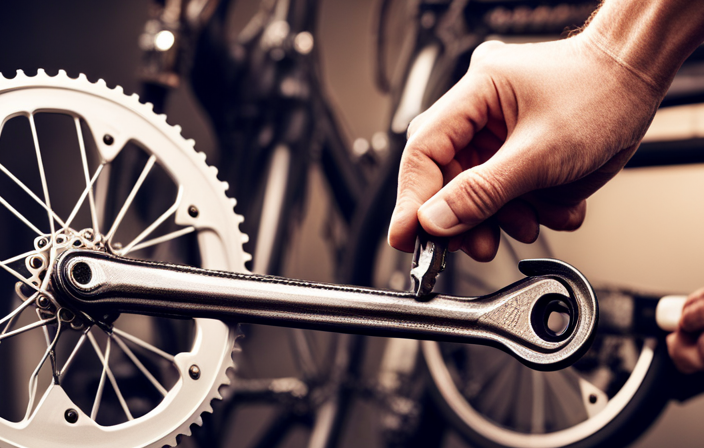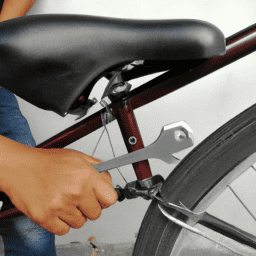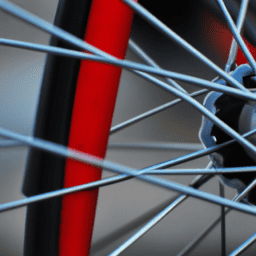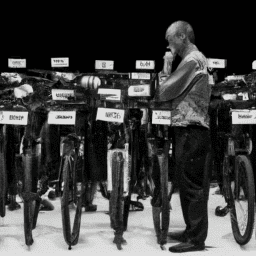Picture yourself embarking on an adventure, cycling through stunning scenery, with the wind in your hair and the excitement of the open road beneath your tires.
But what if you could experience all of this without leaving the comfort of your own home?
In this article, I will guide you through the process of making your bicycle stationary, allowing you to enjoy the benefits of cycling anytime, anywhere.
So, let’s get ready to embark on a new adventure – one that starts right in your living room.
Key Takeaways
- Assess your bike and equipment for damages or loose parts
- Choose the right stationary bike stand that is sturdy, adjustable, and compatible with your bike
- Set up the stand correctly by adjusting the height and position for proper bike posture and ensuring everything is tight and secure
- Secure your bike in the stand by positioning it correctly, aligning the rear axle with the stand’s axle slot, and using quick-release levers or tightening bolts
Assess Your Bike and Equipment
Assess your bike and equipment before attempting to make it stationary. This is an important step to ensure that your bike is properly set up and secure.
Start by checking your bike for any damages or loose parts that need to be fixed. Inspect the tires, brakes, and gears to make sure they are in good working condition. Additionally, assess your equipment, such as the pedals, handlebars, and seat, to see if they need any adjustments or replacements.
Once you have assessed your bike and equipment, you can move on to choosing the right stationary bike stand. This stand should be sturdy, adjustable, and compatible with your bike. It will provide stability and support while you ride indoors.
Choose the Right Stationary Bike Stand
Consider selecting the appropriate stationary bike stand for your needs. When choosing the right stationary bike stand, there are several factors to consider. Firstly, think about the type of stand you prefer. There are three main types: fluid, magnetic, and wind. Each offers different levels of resistance and noise levels. Secondly, consider the stability of the stand. Look for a sturdy and durable stand that can support your bike’s weight. Finally, think about the adjustability of the stand. It should be easy to set up and adjust to fit your bike securely. Using a stationary bike stand has many benefits, such as allowing you to exercise indoors regardless of the weather and providing a consistent and controlled workout environment. With the right stand, you can easily set up your stationary bike and start pedaling in no time.
Set Up Your Stationary Bike Stand
To set up your stationary bike stand, start by ensuring that it is stable and secure. Here are three important steps to consider when setting up your stand:
-
Choosing the right stand: Look for a stand that is compatible with your bike’s size and weight. Consider factors such as adjustable resistance levels and stability features. This will ensure a smooth and comfortable workout experience.
-
Setting up proper bike posture: Adjust the height and position of the stand to match your bike’s specifications. Make sure the bike is level and that the saddle is at the appropriate height. This will help prevent strain and discomfort during your workout.
-
Secure your bike in the stand: Use the provided clamps or straps to firmly attach your bike to the stand. Double-check that everything is tight and secure before starting your workout.
By following these steps, you can set up your stationary bike stand correctly and enjoy a safe and effective workout.
Now, let’s move on to securing your bike in the stand.
Secure Your Bike in the Stand
Now let’s see how to securely lock your bike in the stand. When it comes to bike stand options, there are several types available in the market. Whether you have a wheel-on stand or a direct drive stand, the key is to position your bike correctly to ensure stability and avoid any accidents during your stationary ride. First, make sure the bike is level by adjusting the stand’s height if needed. Then, place the bike in the stand, aligning the rear axle with the stand’s axle slot. Use the quick-release lever or tighten the bolts to secure the bike in place. To give you a visual representation, here’s a table showcasing different bike stand options and their features:
| Stand Type | Description |
|---|---|
| Wheel-on Stand | Attaches to the bike’s rear wheel and provides resistance through a roller. |
| Direct Drive Stand | Replaces the bike’s rear wheel and connects directly to the drivetrain. |
Now that your bike is securely in the stand, let’s move on to adjusting the resistance level.
Adjust the Resistance Level
To adjust the resistance level, simply turn the dial on your bike stand. Most bike stands have a resistance knob that allows you to increase or decrease the difficulty of your workout.
Turning the knob clockwise increases the resistance, making it harder to pedal, while turning it counterclockwise decreases the resistance, making it easier. Experiment with different resistance levels to find the one that suits your fitness level and goals.
If you’re just starting out, it’s a good idea to begin with a lower resistance and gradually increase it as you get stronger. Remember to listen to your body and adjust the resistance accordingly.
Once you’ve adjusted the resistance level, you can move on to setting up a comfortable cycling environment without any hassle.
Set Up a Comfortable Cycling Environment
Create a comfortable cycling environment by adjusting the seat height and position to ensure a proper fit for your body. Start by setting the seat height so that your knees are slightly bent when the pedals are at the lowest point. This will prevent strain on your knees and allow for a more efficient pedal stroke.
Next, adjust the seat position forward or backward to find a comfortable distance from the handlebars. This will help you maintain proper cycling posture, with a slight bend in your elbows and a relaxed grip on the handlebars. A proper bike fit is crucial to prevent discomfort and injury, so take the time to make these adjustments before getting started.
Now, let’s move on to the next section about warming up and stretching before starting.
Warm Up and Stretch Before Starting
Before starting my cycling workout, I always make sure to warm up and stretch properly.
I begin with dynamic warm-up exercises, such as leg swings and arm circles, to increase my heart rate and loosen up my muscles.
Then, I move on to stretching major muscle groups like my quadriceps, hamstrings, and calves to improve flexibility and prevent injury.
By taking the time to warm up and stretch, I can ensure a safe and effective cycling session.
Perform Dynamic Warm-up Exercises
Performing dynamic warm-up exercises is essential before making a bicycle stationary. Warm-up routines are crucial to prepare the body for the physical demands of cycling and to prevent injuries.
Dynamic stretching, which involves moving parts of the body through a full range of motion, offers numerous benefits. It increases blood flow, warms up the muscles, and improves joint mobility. These exercises also activate and engage specific muscle groups that will be used during cycling, such as the quadriceps, hamstrings, and glutes.
By incorporating dynamic warm-up exercises into your routine, you can enhance your performance and reduce the risk of strains or pulls. Once you have completed these exercises, it’s time to transition into the next step of the warm-up process, which is to stretch major muscle groups.
Stretch Major Muscle Groups
To properly prepare your body for cycling, you should stretch major muscle groups as part of your warm-up routine. Stretching techniques are essential to increase flexibility, improve range of motion, and prevent injuries.
Start by stretching your quadriceps, which are the muscles located at the front of your thighs. Stand upright, bend your knee, and bring your foot towards your buttocks, holding it for 20-30 seconds on each leg.
Next, stretch your hamstrings by sitting on the ground with one leg extended, and the other bent with the sole of your foot touching the inner thigh of your extended leg. Lean forward, reaching towards your extended leg, and hold for 20-30 seconds.
Finally, stretch your calves by standing near a wall, placing one foot forward and leaning into the wall, keeping your back leg straight. Hold for 20-30 seconds on each leg.
Stretching major muscle groups before cycling will improve your performance and reduce the risk of muscle strains and cramps.
Now that you’ve properly stretched, it’s time to start cycling and monitor your progress.
Start Cycling and Monitor Your Progress
When starting to cycle, it’s important to begin at a comfortable pace. This allows your body to warm up gradually and prevents any strain or injuries.
As you ride, make sure to track your distance, time, and calories burned. This not only helps you monitor your progress but also allows you to set goals and track your improvement over time.
Begin with a Comfortable Pace
Start off at a comfortable pace to make your bicycle stationary.
Here are four important things to keep in mind when starting at a comfortable pace.
First, make sure to maintain a relaxed grip on the handlebars to prevent unnecessary strain on your hands and arms.
Second, focus on keeping your back straight and your core engaged to maintain proper form and stability.
Third, pedal smoothly and evenly, avoiding any sudden jerking or heavy pushing.
Finally, be mindful of your breathing, taking deep breaths and exhaling fully to help relax your body.
By starting at a comfortable pace with these key points in mind, you’ll be able to gradually build up your endurance and confidence on the bike.
Now, let’s move on to tracking your distance, time, and calories burned.
Track Distance, Time, and Calories Burned
Tracking your distance, time, and calories burned is essential for monitoring your progress and achieving your fitness goals. By keeping track of these metrics, you can easily see how far you’ve come and measure your performance over time.
Not only does tracking your progress provide motivation, but it also allows you to set realistic goals and make necessary adjustments to your workout routine. There are various ways to track your distance, time, and calories burned while cycling. You can use a fitness tracker, a smartphone app, or even a simple pen and paper.
Whichever method you choose, make sure to record your data consistently and accurately. This information will help you analyze your performance and identify areas for improvement.
Now that you know how to track your progress, let’s move on to incorporating interval training and challenges into your stationary bicycle workout routine.
Incorporate Interval Training and Challenges
To amp up your workout, incorporate interval training and challenges into your stationary bicycle routine.
Interval training benefits include increased calorie burn and improved cardiovascular fitness.
To incorporate interval training, start by warming up for 5 minutes at an easy pace. Then, increase your speed and resistance for 30 seconds to 1 minute, pushing yourself to a challenging level. After that, lower the intensity for the same amount of time to recover. Repeat this cycle for 20-30 minutes.
Additionally, you can incorporate resistance challenges by increasing the resistance level on your stationary bicycle. This will make your muscles work harder and provide a more intense workout.
Remember to stay hydrated and take breaks as needed to prevent fatigue and ensure a safe and effective workout.
Stay Hydrated and Take Breaks as Needed
Remember to stay hydrated and take breaks as needed to ensure a safe and effective workout on your stationary bike.
Hydration is key to maintaining your energy levels and preventing dehydration during your workout. Make sure to have a water bottle within reach and take small sips throughout your session.
As you pedal away, it’s important to listen to your body and take breaks when necessary. Pushing yourself too hard without giving your muscles and joints a chance to rest can lead to fatigue and injury.
During your breaks, you can stretch your legs, grab a quick snack, or simply take a few moments to catch your breath.
By staying hydrated and taking breaks, you’ll be able to maximize your workout and avoid any potential negative effects.
Now, let’s move on to the next section about cooling down and stretching after your workout.
Cool Down and Stretch After Your Workout
After a rigorous workout on my stationary bike, it’s important to cool down and give my body the chance to gradually return to its normal state. Cool down exercises are a crucial part of any workout routine, as they help reduce the risk of injury and prevent muscle soreness.
I like to start with a few minutes of slow cycling to gradually decrease my heart rate. Then, I move on to stretching exercises to increase flexibility and relieve any tightness in my muscles. Stretching not only feels great, but it also improves blood circulation and helps with muscle recovery.
By taking the time to cool down and stretch after my workout, I’m setting myself up for success in future workouts.
Now, let’s move on to the next step and learn how to clean and maintain your stationary bike.
Clean and Maintain Your Stationary Bike
Keeping your stationary bike clean and properly maintained is essential for its longevity and optimal performance.
To maintain your bike’s performance, start by regularly wiping down the frame, seat, and handlebars with a damp cloth to remove sweat and dirt. Make sure to clean the pedals and resistance mechanism as well.
Additionally, check the tension on the belt or chain and adjust it if necessary to ensure a smooth ride. To prevent rust and corrosion, apply a thin layer of lubricant to the bike’s moving parts, such as the chain, crank, and flywheel. This will also help reduce friction and noise.
Finally, inspect the bike for any loose or damaged parts and tighten or replace them as needed. With proper maintenance, your stationary bike will continue to provide a reliable and enjoyable workout experience.
As you explore virtual cycling apps and programs, you’ll be able to fully immerse yourself in exciting virtual rides.
Explore Virtual Cycling Apps and Programs
When it comes to enhancing my stationary bike experience, I have found that virtual routes and challenges are a game-changer. These apps and programs allow me to explore different locations and terrains without leaving the comfort of my home.
Not only does it make my workouts more interesting, but it also provides a sense of accomplishment as I conquer new challenges. Additionally, joining online cycling communities has been a great source of motivation for me.
Being able to connect with like-minded individuals who share the same passion for cycling keeps me accountable and pushes me to reach new goals.
Enhance Your Experience with Virtual Routes and Challenges
To enhance your experience with virtual routes and challenges, you can use an app that offers interactive courses and competitive challenges. These apps provide a virtual reality gaming experience, allowing you to feel like you’re actually riding through different locations and terrains.
With realistic simulations and immersive graphics, you’ll feel as if you’re part of the action. Additionally, these apps often offer indoor cycling classes led by professional instructors, giving you the opportunity to join virtual group workouts and receive guidance on proper form and technique.
You can also compete against other users in virtual races and challenges, adding a competitive element to your indoor cycling sessions. By incorporating virtual routes and challenges into your workouts, you’ll stay engaged and motivated to achieve your fitness goals.
Joining online cycling communities for motivation is the next step to further enhance your indoor cycling experience.
Join Online Cycling Communities for Motivation
Joining online cycling communities can provide you with the motivation and support you need to stay committed to your indoor cycling routine. These communities offer a platform where you can connect with fellow cyclists, share your progress, and participate in virtual cycling races.
Engaging in virtual races not only adds excitement to your workouts but also allows you to challenge yourself against other cyclists from around the world. Additionally, many online cycling communities offer the option of online coaching. This means you can receive expert guidance and personalized training plans to help you reach your fitness goals.
By being a part of these communities, you can surround yourself with like-minded individuals who share your passion for cycling and provide the encouragement and motivation you need to keep pushing yourself.
As you continue on your indoor cycling journey, it’s important to mix up your workouts and stay motivated, which we’ll explore in the next section.
Mix Up Your Workouts and Stay Motivated
When it comes to staying motivated in my cycling workouts, I like to mix things up and try different techniques.
One of my favorites is hill climbing, which really challenges my muscles and helps improve my overall strength.
I also like to incorporate sprints into my rides, which not only adds intensity but also helps improve my speed.
To keep myself motivated, I always set achievable goals for each workout and reward myself when I reach them.
This helps me stay focused and gives me something to look forward to after a challenging ride.
Try Different Cycling Techniques (e.g., Hill Climbing, Sprints)
Experiment with various cycling techniques to improve your stationary biking skills. Here are three techniques you can try to take your workout to the next level:
-
Hill sprints: Increase the resistance on your stationary bike and pedal as fast as you can for a short burst of time. This will challenge your leg muscles and improve your cardiovascular endurance.
-
Endurance training: Set a moderate resistance level and maintain a steady pace for an extended period of time. This will help build your stamina and increase your overall endurance.
-
Interval training: Alternate between periods of high-intensity cycling and recovery periods of lower intensity. This will improve your cardiovascular fitness and help burn more calories.
By incorporating these techniques into your stationary biking routine, you can challenge yourself and keep your workouts exciting. As you progress, it’s important to set achievable goals and reward yourself for your hard work.
Set Achievable Goals and Reward Yourself
To keep yourself motivated, set achievable goals and reward yourself when you reach them. Achieving success in any endeavor requires a clear vision and a plan to get there.
When it comes to stationary cycling, it’s no different. Start by setting realistic goals that align with your fitness level and desired outcomes. For example, you could aim to increase your cycling duration by five minutes each week or reach a specific distance milestone.
Once you achieve these goals, reward yourself with something you enjoy, like a massage or a new cycling accessory. This self-reward system will not only motivate you to keep pushing forward but also give you something to look forward to.
By setting achievable goals and rewarding yourself along the way, you can stay motivated and enjoy the benefits of stationary cycling without feeling overwhelmed.
Enjoy the Benefits of Stationary Cycling
Get ready to experience the benefits of stationary cycling! Virtual cycling is a fantastic way to enjoy the benefits of indoor cycling, all from the comfort of your own home. Not only does it provide a convenient and efficient workout, but it also offers a range of advantages that can enhance your fitness journey.
Here are some virtual cycling benefits and indoor cycling tips to make the most out of your stationary biking experience:
-
Immersive Experience: With virtual cycling, you can explore various scenic routes and challenging terrains, making your workout more engaging and exciting.
-
Customizable Workouts: Indoor cycling allows you to adjust the resistance levels, incline, and speed to personalize your workouts according to your fitness goals and preferences.
-
Interactive Training Programs: Many virtual cycling platforms offer interactive training programs led by professional instructors, providing guidance, motivation, and a sense of community.
By incorporating these tips and taking advantage of the benefits of stationary cycling, you can elevate your fitness routine and achieve your goals effectively. So, get ready to pedal your way to a healthier and fitter you!
Frequently Asked Questions
Can I use any type of bicycle for stationary cycling?
Yes, you can use any type of bicycle for stationary cycling. It offers numerous benefits such as cardiovascular fitness, muscle toning, and weight loss. To set up a stationary bike at home, choose a level surface, adjust the seat height, and secure the bike in place.
How do I choose the right resistance level for my stationary bike?
To choose the right resistance level for your stationary bike, start by considering your fitness level and goals. Increasing resistance can help build strength and endurance, while decreasing it allows for a faster pace and recovery. Interval training offers additional benefits by alternating between high and low resistance levels.
Are there any safety measures I should consider when securing my bike in the stand?
When securing my bike in the stand, I prioritize bike stand safety and preventing theft. I make sure to lock the bike frame to the stand using a sturdy lock and remove any detachable parts.
What are some common interval training exercises I can incorporate into my stationary cycling routine?
To effectively warm up before a stationary cycling routine, try light pedaling for 5-10 minutes. To track and analyze your progress in interval training, use a heart rate monitor and keep a log of your workouts.
How often should I clean and maintain my stationary bike?
To keep my stationary bike in top shape, I clean it regularly using a gentle cleaner and a soft cloth. I also make sure to lubricate the parts every few months to keep them running smoothly.
Conclusion
All in all, mastering the art of making a bicycle stationary opens up a world of possibilities for your fitness journey.
Just like a seasoned cyclist conquers challenging terrains, you too can conquer your personal fitness goals with determination and perseverance.
So, hop on your stationary bike, embrace the resistance, and pedal your way to a healthier and stronger version of yourself.
Remember, every pedal stroke brings you closer to the finish line of your fitness journey. Keep pushing forward and enjoy the ride!









